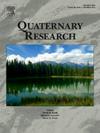阿肯色州布法罗国家河沿岸岩床河切口和阶地发育的岩性和气候作用
IF 1.8
3区 地球科学
Q3 GEOGRAPHY, PHYSICAL
引用次数: 0
摘要
摘要阿肯色州西北部的布法罗国家河保存了大量第四纪河流基岩切割和沉积的记录,这些记录跨越了各种阻力的岩性。在这项工作中,我们将光激发光(OSL)测年应用于布法罗河沿岸的地层和填充阶地,以阐明岩性和气候对两个最年轻阶地单元(Qtm和Qty)发育的作用。我们的OSL年龄表明,Qtm阶地的最小地层平坦化年龄约为250 ka,随后是约200 ka的沉积记录。Qtm切口可能发生在最后一次冰川盛期(LGM)附近,在Qty填充阶地沉积开始之前,约14ka。我们的阶地年龄与其他区域阶地记录大致一致,与现有古气候档案的比较表明,阶地沉积和切割分别发生在更干燥和更潮湿的水文条件下。还使用OSL得出的Qtm地层平面化估计值计算了垂直基岩切口率,并显示出与基岩岩性具有统计学意义的空间变异性,高阻力河段为~35 mm/ka,低阻力河段为~16 mm/ka。结合对河谷宽度和阶地分布的观测,这些结果表明,在阻力较大的岩性河段,垂直过程大于横向过程。本文章由计算机程序翻译,如有差异,请以英文原文为准。
The role of lithology and climate on bedrock river incision and terrace development along the Buffalo National River, Arkansas
Abstract The Buffalo National River in northwest Arkansas preserves an extensive Quaternary record of fluvial bedrock incision and aggradation across lithologies of variable resistance. In this work, we apply optically stimulated luminescence (OSL) dating to strath and fill terraces along the Buffalo River to elucidate the role of lithology and climate on the development of the two youngest terrace units (Qtm and Qty). Our OSL ages suggest a minimum strath planation age of ca. 250 ka for the Qtm terraces followed by a ca. 200 ka record of aggradation. Qtm incision likely occurred near the last glacial maximum (LGM), prior to the onset of Qty fill terrace aggradation ca. 14 ka. Our terrace ages are broadly consistent with other regional terrace records, and comparison with available paleoclimatic archives suggests that terrace aggradation and incision occurred during drier and wetter hydrological conditions, respectively. Vertical bedrock incision rates were also calculated using OSL-derived estimates of Qtm strath planation and displayed statistically significant spatial variability with bedrock lithology, ranging from ~35 mm/ka in the higher resistance reaches and ~16 mm/ka in the lower resistance reaches. In combination with observations of valley width and terrace distribution, these results suggest that vertical processes outpace lateral ones in lithologic reaches with higher resistance.
求助全文
通过发布文献求助,成功后即可免费获取论文全文。
去求助
来源期刊

Quaternary Research
地学-地球科学综合
CiteScore
4.70
自引率
8.70%
发文量
57
审稿时长
3 months
期刊介绍:
Quaternary Research is an international journal devoted to the advancement of the interdisciplinary understanding of the Quaternary Period. We aim to publish articles of broad interest with relevance to more than one discipline, and that constitute a significant new contribution to Quaternary science. The journal’s scope is global, building on its nearly 50-year history in advancing the understanding of earth and human history through interdisciplinary study of the last 2.6 million years.
 求助内容:
求助内容: 应助结果提醒方式:
应助结果提醒方式:


